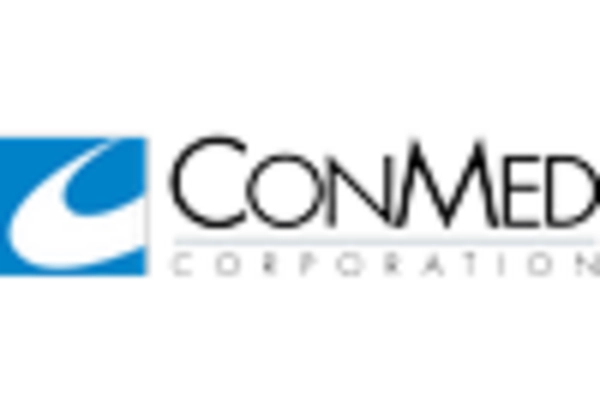Rising Prevalence of Chronic Diseases
The increasing incidence of chronic diseases such as cancer, cardiovascular disorders, and obesity in the GCC region is a primary driver for the radiofrequency ablation-devices market. As healthcare providers seek effective treatment options, radiofrequency ablation emerges as a minimally invasive solution that offers significant benefits. According to recent data, the prevalence of diabetes in the GCC has reached alarming levels, with estimates suggesting that over 20% of the adult population is affected. This trend necessitates advanced treatment modalities, thereby propelling the demand for radiofrequency ablation devices. Furthermore, the growing awareness among patients regarding the advantages of these devices, including reduced recovery times and lower complication rates, is likely to enhance market growth. the radiofrequency ablation-devices market is positioned to expand.
Regulatory Support and Standardization
Regulatory bodies in the GCC region are increasingly supporting the radiofrequency ablation-devices market through the establishment of clear guidelines and standards. This regulatory framework is essential for ensuring the safety and efficacy of medical devices, which in turn fosters confidence among healthcare providers and patients. The approval processes for new devices are becoming more streamlined, encouraging manufacturers to innovate and bring new products to market. Additionally, the collaboration between regulatory agencies and industry stakeholders is likely to enhance the overall quality of radiofrequency ablation devices. As a result, the market is expected to benefit from a more favorable regulatory environment, which may lead to increased adoption of these devices in clinical practice. The emphasis on standardization is also likely to improve interoperability between devices, further driving growth in the radiofrequency ablation-devices market.
Growing Awareness and Patient Education
There is a notable increase in awareness and education regarding radiofrequency ablation among both healthcare professionals and patients in the GCC region. This heightened awareness is driven by various initiatives aimed at informing stakeholders about the benefits and applications of radiofrequency ablation devices. Medical conferences, workshops, and online resources are contributing to a better understanding of these technologies. As patients become more informed about their treatment options, they are more likely to seek out radiofrequency ablation as a viable alternative to traditional surgical procedures. This shift in patient preference is expected to drive demand within the radiofrequency ablation-devices market. Moreover, healthcare providers are increasingly incorporating radiofrequency ablation into their treatment protocols, further solidifying its role in modern medical practice. The combination of patient education and professional training is likely to enhance the market's growth trajectory.
Investment in Healthcare Infrastructure
The GCC countries are witnessing substantial investments in healthcare infrastructure, which is likely to bolster the radiofrequency ablation-devices market. Governments are prioritizing the enhancement of healthcare facilities, leading to the establishment of advanced medical centers equipped with state-of-the-art technology. For instance, the UAE has allocated over $10 billion for healthcare development in recent years, focusing on improving patient care and access to innovative treatments. This investment trend is expected to facilitate the adoption of radiofrequency ablation devices, as hospitals and clinics upgrade their equipment to meet international standards. Additionally, the influx of private sector investments is further stimulating the market, as private healthcare providers seek to offer cutting-edge treatment options. Consequently, the radiofrequency ablation-devices market will benefit from this ongoing transformation in the healthcare landscape.
Technological Innovations in Device Design
Technological advancements in the design and functionality of radiofrequency ablation devices are significantly influencing the market. Innovations such as improved electrode designs, enhanced energy delivery systems, and integration with imaging technologies are making procedures safer and more effective. For instance, the development of multi-electrode systems allows for more precise ablation, reducing the risk of damage to surrounding tissues. These advancements not only improve patient outcomes but also increase the efficiency of procedures, making them more appealing to healthcare providers. As a result, the radiofrequency ablation-devices market is likely to experience growth as hospitals and clinics adopt these cutting-edge technologies. Furthermore, ongoing research and development efforts are expected to yield even more sophisticated devices, potentially expanding the range of applications for radiofrequency ablation in various medical fields.

















Leave a Comment